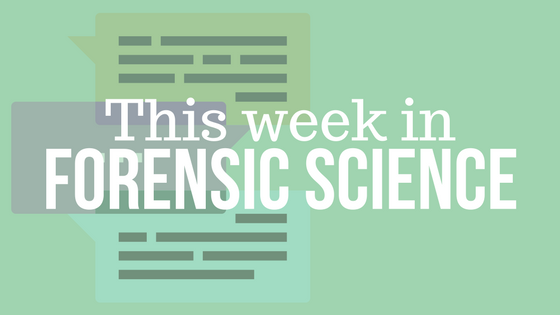No one has hours to scour the papers to keep up with the latest news, so we’ve curated the top news stories in the field of Forensic Science for this week. Here’s what you need to know to get out the door!
Investigators use DNA, Genealogy Database to ID Suspect in 1987 Double Homicide (The Seattle Times – 5/18/2018)
More than 30 years after a young Canadian woman was raped and shot in the back of the head, a 55-year-old SeaTac man was arrested Thursday in connection with her death after DNA found at the crime scene was used to map the suspect’s family tree, according to the Snohomish County Sheriff’s Office.
International Consortium Wants to Sequence the DNA of 1.5 Million Species (R&D Magazine – 5/18/2018)
To fill the huge knowledge gap and develop the scientific, economic, social and environmental potential of Earth’s eukaryotic biodiversity, an international consortium plans to sequence, catalogue and characterize the genomes of every eukaryotic species on Earth within ten years.
State Developing Computer Program to Allow Victims to Track Sexual Assault Test Results (Richmond Times-Dispatch – 5/20/2018)
New software that will allow sexual assault victims to track the analysis of evidence in their cases is under development for the Virginia Department of Forensic Science.
NamUs 2.0: Faster, More In-Depth on Its First Day Debut (Forensic Magazine – 5/21/2018)
Today the National Missing and Unidentified Persons System has launched its “2.0”—the second version of the database.
The system is sleeker, faster—and comes with new options that may make that crucial breakthrough in untold cases of the future, according to officials.
Every Cell In Your Body Has the Same DNA. Except it Doesn’t. (New York Times – 5/21/2018)
We’re accustomed to thinking of our cells sharing an identical set of genes, faithfully copied ever since we were mere fertilized eggs. When we talk about our genome — all the DNA in our cells — we speak in the singular.
But over the course of decades, it has become clear that the genome doesn’t just vary from person to person. It also varies from cell to cell. The condition is not uncommon: We are all mosaics.
LLNL-Led Team Expands Forensic Method to Identify People Using Proteins From Bones (Lawrence Livermore National Laboratory – 5/21/2018)
In September 2016, LLNL scientists announced they had developed a science-based, statistically validated way to use protein markers from human hair to identify people and link individuals to evidence.
Now they’ve found a second way to use protein markers from human tissue for identification — this time from bones. Their work is described in a paper published online by Forensic Science International, an Amsterdam-based journal.
Scientists to Hunt for DNA Traces of Loch Ness Monster (Newsweek – 5/21/2018)
- Next month, however, an international team of scientists led by Neil Gemmell from the University of Otago, New Zealand, will conduct an investigation into the waters of the famous loch which could help settle the mystery once and for all.
Minnesota’s Rape Kit Reform Bill Becomes a Law as Duluth Passes a Milestone on its Backlog (StarTribune – 5/23/2018)
In Minnesota’s most ambitious effort to process untested rape kits, the Duluth Police Department has eliminated its entire backlog and submitted 415 kits for laboratory testing, a step that could open the door to justice for scores of sexual assault victims.
Hitler’s Teeth and Skull Provide ‘Definitive Identification’ (Forensic Magazine – 5/23/2018)
- Adolf Hitler did indeed die in his bunker in April 1945—and the few charred fragments left of his bones and dental work prove that the conspiracy theories about his escape from under the march of the Allies at the end of World War II are bogus, according to a new study in the European Journal of Internal Medicine.The French team, led by Philippe Charlier of the UFR des Sciences de la Santé, were among the few to actually get a good hard look at the part of a jaw and upper skull, which were the only mortal remains of the infamous German dictator.
Your DNA is the Next Big Privacy Battleground (THINK – 5/22/2018)
Are we on the verge of another Cambridge Analytica-type meltdown? Lawyer Stephen Mercer thinks so. Except this time, it’s our own DNA we should be worried about. Mercer has practiced at the intersection of DNA and civil liberties since 2002, when he litigated the first constitutional challenge to Maryland’s DNA databank.
Estimated 7,000 Bodies May Be Buried at Former Asylum (Sacramento Bee – 5/23/2018)
These humble remains are among as many as 7,000 bodies that were buried at Mississippi’s former insane asylum, a site that’s now on the grounds of the University of Mississippi Medical Center in Jackson. Researchers are planning to exhume the bodies, create a memorial and study them for insight on how mentally ill people and other marginalized populations should be treated today.
Golden State Killer Backlash? Public Databases Shutting Down in Wake of Arrest (Forensic Magazine – 5/24/2018)
- Today, one of the genealogy tools that has been used to catch killers is shutting its doors—and some scientists told Forensic Magazine searches of the future will be a little more difficult.FamilyTree DNA is removing all access to its free and public genetic genealogy databases ysearch.org and mitosearch.org, according to an announcement they sent out last week.
German Law Allows Use of DNA to Predict Suspects’ Looks (Science – 5/25/2018)
- Police in the German state of Bavaria now have the authority to analyze forensic DNA samples to predict the geographical ancestry and physical characteristics—hair color, eye color, skin color, and age—of an unknown suspect who poses an imminent danger. The controversial law, which passed the Landtag, the state parliament in Munich, on 15 May, is the first in Germany to allow what has been dubbed DNA phenotyping, and it has sparked renewed debate here and in other countries about the advantages—and risks—of such methods..
WOULD YOU LIKE TO SEE MORE ARTICLES LIKE THIS? SUBSCRIBE TO THE ISHI BLOG BELOW!


